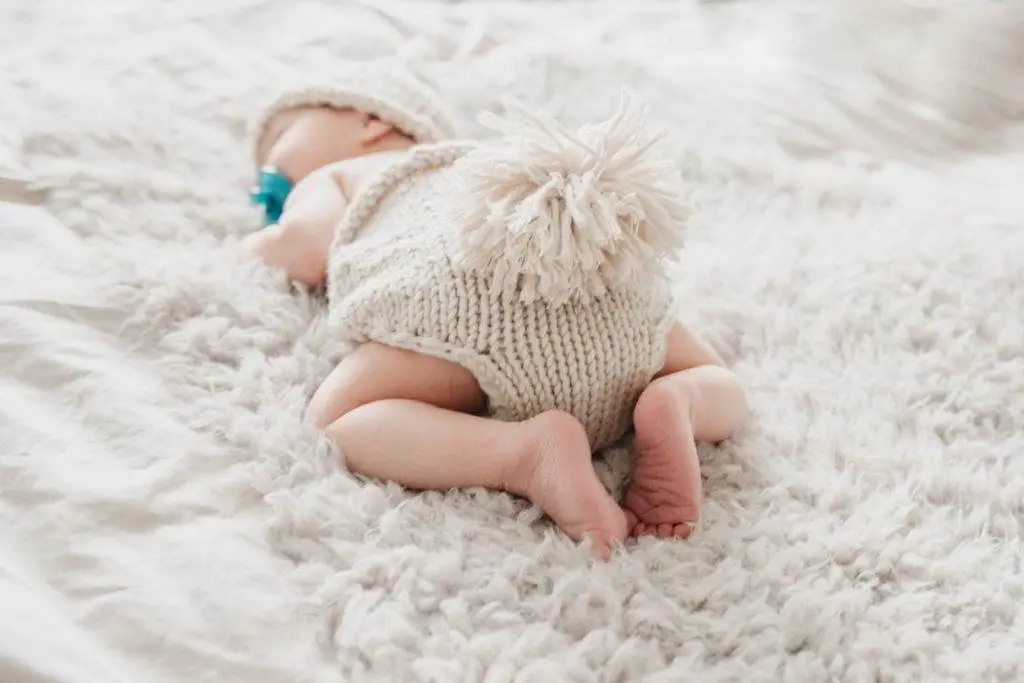Introduction: Understanding Baby Sleep Patterns
As a parent, understanding your baby’s sleep patterns can be both fascinating and challenging. Babies have unique ways of sleeping that differ significantly from adults. This article aims to shed light on these patterns and help you decode your baby’s sleep behaviors.
Importance of observing baby sleep behaviors
Observing your baby’s sleep behaviors is crucial for several reasons. It can help you understand their comfort levels, identify any potential health issues, and establish a suitable sleep routine. By being attentive to your baby’s sleep patterns, you can ensure they are getting the rest they need for healthy development.
Normal baby sleep positions
Babies often sleep in positions that may seem unusual to adults. One common position is the ‘butt up’ or ‘knees tucked under’ position. While it may look uncomfortable, this is a normal and healthy sleep position for babies. We’ll delve deeper into this topic later in the article.
Brief overview of the article
In this article, we will explore the science behind baby sleep habits, focusing on why babies often sleep with their butts up. We’ll also share a case study that provides a closer look at baby sleep postures. Finally, we’ll wrap up with key takeaways and a conclusion that embraces the mystery of baby sleep behaviors.
Whether you’re a new parent or an experienced one, this article will provide valuable insights into your baby’s sleep patterns. So, let’s dive in and unravel the mystery of baby sleep behaviors together.
Decoding Infant Sleep Habits
Understanding your baby’s sleep habits can be a fascinating journey. As parents, we often find ourselves puzzled by the various positions our babies adopt while sleeping. Let’s delve into the common baby sleep positions and their meanings.
Common Baby Sleep Positions and Their Meanings
There are several common positions that babies adopt during their sleep. Each of these positions can tell us something about the baby’s comfort, development, and safety.
1. Back Sleeping
Back sleeping is the safest position for a baby. It significantly reduces the risk of Sudden Infant Death Syndrome (SIDS). This position allows for optimal oxygen flow and is recommended by the American Academy of Pediatrics. If your baby sleeps on their back, it’s a sign they are following their natural instincts for safety.
2. Stomach Sleeping
While some babies might find stomach sleeping comfortable, it’s important to note that this position can increase the risk of SIDS. Babies might turn to their stomachs if they are experiencing discomfort from gas or colic. However, always ensure to turn them back onto their backs once they fall asleep.
3. Side Sleeping
Side sleeping is common among babies, especially those who are transitioning between back and stomach positions. While it’s less risky than stomach sleeping, it’s still safer to encourage back sleeping. Babies often adopt this position when they start to learn how to roll over.
4. Babies Sleeping with Butts in the Air
This adorable position is a favorite among parents for its cuteness! Babies often sleep with their butts in the air because it’s a position they’ve known since they were in the womb. It’s comfortable, natural, and a sign that your baby is growing and developing normally.
Decoding your baby’s sleep habits can provide valuable insights into their development and well-being. Always remember, each baby is unique and might have their preferred sleep positions. However, for safety, always encourage back sleeping.
Why Babies Sleep with Butts Up: The Science Behind It

Ever wondered why your little one often ends up sleeping with their butt in the air? It’s a common sleep position among babies, and there’s actually some science behind it. Here are three key reasons:
Comfort and security
Firstly, this position can provide a sense of comfort and security for babies. It’s a position they’re familiar with, as it’s similar to the fetal position they were in while in the womb. This can make them feel safe and secure, helping them to sleep better. According to a Wikipedia article, the fetal position is a comforting natural instinct for many mammals, not just humans.
Developmental reasons
Secondly, there are developmental reasons. As babies grow and develop, they start to explore different movements and positions. The butt-up position is a milestone in their physical development, showing that they’re learning to crawl. It’s a sign that their muscles are developing as they should be.
Flexibility and natural instinct
Lastly, babies are naturally flexible, and the butt-up position is a natural instinct that allows them to stretch and move comfortably. This position can also help to relieve gas, making it a comfortable position for babies with upset tummies.
So, the next time you see your baby sleeping with their butt in the air, remember that it’s a natural and healthy part of their development. It’s just one of the many fascinating aspects of baby behavior that we’re still learning about.
Case Study: Observing Baby Sleep Postures
Understanding the sleep postures of babies can provide insights into their comfort and overall well-being. Let’s delve into some real-life examples of babies sleeping on their stomachs.
Real-life Examples of Babies Sleeping on Their Stomachs
While it is generally advised for babies to sleep on their backs to reduce the risk of Sudden Infant Death Syndrome (SIDS), some babies may naturally roll onto their stomachs as they grow older and gain more control over their movements. Here are three case studies that illustrate this behavior:
- Case Study 1: Baby Mia, a 7-month-old, started rolling onto her stomach during sleep. Her parents noticed that she seemed more comfortable and slept for longer periods in this position. However, they ensured her crib was free of loose bedding and soft toys to minimize any potential risks.
- Case Study 2: Baby Ethan, a 9-month-old, preferred sleeping on his stomach. His parents observed that he would often lift his butt in the air, a posture known as the ‘baby yoga’ position. This posture is common among babies and is believed to be a comforting position that mimics the fetal position.
- Case Study 3: Baby Olivia, an 8-month-old, would roll onto her stomach and sleep with her arms spread out. Her parents found that she would wake up less frequently and seemed more rested in the morning when she slept in this position.
These case studies highlight the diversity in baby sleep postures. It’s important to remember that each baby is unique and may have different sleep preferences. However, safety should always be the top priority. Always consult with a pediatrician if you have any concerns about your baby’s sleep habits.
Key Takeaways: Reasons for Babies Sleeping with Butts in the Air

There are several reasons why babies adopt this unique sleeping posture. Let’s summarize the main points and provide some practical tips for parents.
- Summary of the main points:
Babies sleep with their butts in the air because it’s a position they’re familiar with, as it’s similar to their position in the womb.
This posture can also be a sign of self-soothing, as it allows babies to rock themselves to sleep.
It’s a natural position that promotes better digestion and reduces the risk of sudden infant death syndrome (SIDS).
Most importantly, if your baby is comfortable and can sleep well in this position, it’s perfectly fine and safe.
- Practical tips for parents:
Always place your baby on their back to sleep. If they roll over on their own, it’s okay to leave them in the position they find comfortable.
Ensure the crib or sleeping area is safe. Remove any loose bedding, toys, or pillows that could pose a suffocation risk.
Monitor your baby’s sleep patterns. If you notice any changes or if your baby seems uncomfortable, consult your pediatrician.
Remember, every baby is unique. What works for one might not work for another. Always follow your baby’s cues and consult with a healthcare professional if you have any concerns.
In conclusion, the mystery of why babies sleep with their butts in the air is not so mysterious after all. It’s a natural, comfortable position that echoes their time in the womb. As parents, understanding these small quirks can help us better care for our little ones and ensure their comfort and safety.
Conclusion: Embracing the Mystery of Baby Sleep Behaviors
As we draw this enlightening journey to a close, it’s important to remember that understanding your baby’s sleep patterns is not just about decoding the mystery behind their adorable, yet puzzling, sleep postures. It’s about gaining insights into their development, comfort, and overall well-being. So, let’s take a moment to reiterate the importance of this understanding and share some final thoughts and advice for parents.
- Reiteration of the importance of understanding baby sleep patterns: Understanding your baby’s sleep patterns can provide valuable insights into their health and development. It’s not just about figuring out why they sleep with their butts up in the air. It’s about observing their sleep habits, noting any changes, and addressing any potential issues promptly. Remember, knowledge is power. The more you understand about your baby’s sleep behaviors, the better equipped you’ll be to ensure their comfort and well-being. For more detailed information, you can refer to Wikipedia’s page on infant sleep training.
- Final thoughts and advice for parents: Parenting is a journey filled with wonder, joy, and a fair share of mysteries. Embrace the journey, including the mystery of your baby’s sleep behaviors. Observe, learn, and adapt. Don’t hesitate to seek professional advice if you’re concerned about your baby’s sleep patterns. Remember, every baby is unique, and what works for one might not work for another. Stay patient, stay observant, and most importantly, enjoy the precious moments with your little one.
In conclusion, while the sight of your baby sleeping with their butt in the air might bring a smile to your face, it’s also a reminder of the fascinating world of infant development. So, keep observing, keep learning, and keep embracing the mystery of baby sleep behaviors.














